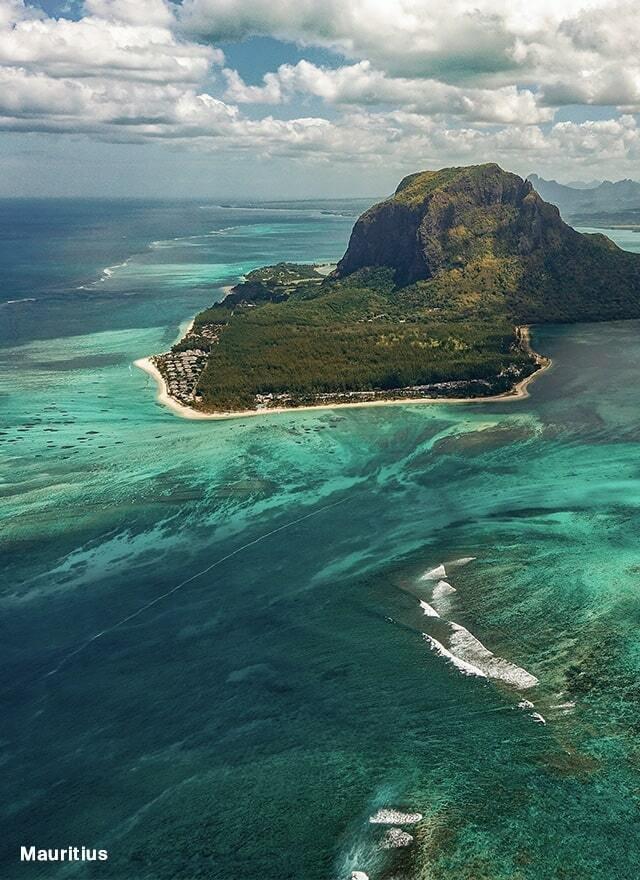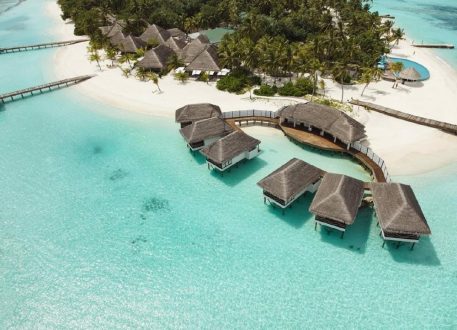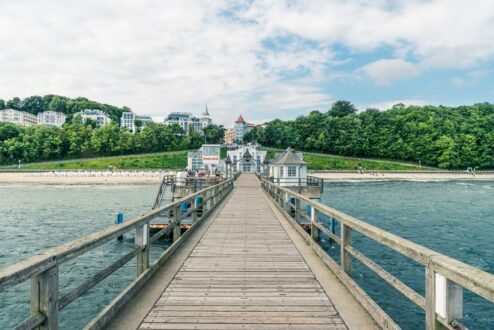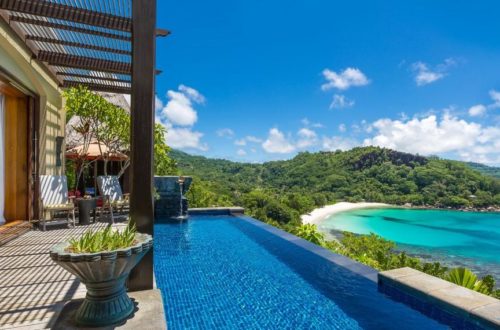
Where to Go in 2023
East coast, Mauritius
A gem near Madagascar in the Indian Ocean, this African island echoes with calls of exotic birds, bats, and insects, reverberating with the sound of its tropical choir. Called “the island where God practiced creating Eden,” Mauritius’ magic lies in not only its unparalleled natural beauty but also its incredible mix of African, Indian, Chinese, and French cultures. To explore the wild side of Mauritius, travelers should head east, where the coast unfurls in unchanged sleepy villages, swathes of raw beachfront, sugarcane fields, mangroves, and lagoons. It feels like a world away from the buzzing nightlife of the north (the island is only 61 kilometers long and 45 kilometers wide) and is where pockets of creativity emerge from hidden corners for those in the know. The EKLA showroom, for example, is a tropical modernist’s paradise, and Le Café des Arts is a one-of-a-kind restaurant and gallery set in a beautifully restored sugar mill.
On this peaceful coast lies the adults-only, new member hotel Salt of Palmar, offering a heady mix of colors, stories, customs, sounds, and flavors. Designer Camille Walala was inspired by the warm shades such as yellows, peaches, and bright blues of the houses dotting the island, as well as the riad style of the hotel’s existing structure, to create its dramatic centerpiece: a black-and-white-striped fountain. The property’s restaurant and rooftop bar tell the story of Mauritius through locally rooted, globally influenced cuisine and creative cocktails inspired by the island’s mountains.
South coast, Lombok, Indonesia
A place where warm turquoise waters curl into barrels and crash against powder-soft sands, framed by sharp cliffs, Lombok’s southern coast is breathtakingly beautiful. While the divine beaches of the Gili Islands to the north have attracted both local and intrepid travelers, the island’s southern coast is slowly emerging as a sustainable alternative to its neighboring Bali. Various initiatives and teams of diving schools are working together to help promote the rejuvenation of damaged reefs, educate fishermen about safe fishing practices, and protect the oceanic habitats from any further destruction.
New developments on the island, such as Somewhere Lombok, are similarly focused on sustainable constructions. The passion project of sisters Claire and Valia Gontard, whose Indonesian roots brought them back to Lombok after worldly travels, is a place that is energy, water, and waste efficient; that works with locals; and that grows vegetation to prevent land erosion. It is also a place where guests are greeted by mesmerizing views of the Are Guling Bay—a world-class surf spot—and a big open communal space that encompasses a reception, restaurant, lounge, bar, lawn, and pool. The sisters also plan to offer the island’s inhabitants opportunities for growth through community projects.
Further along the coast in the secluded Ekas Bay, Innit Lombok is the work of acclaimed Indonesian architects Andra Martin and D-Associates, led by Geogorious Supie Yolodi. Reachable by land or sea, the seven-beach house property intrudes as little as possible on its natural habitat, so much so that the living areas on the ground levels feature sand floors. The inhabitants of the small fishing village have also been enveloped into Innit’s journey, working and learning new skills during construction and now supplying the hotel’s restaurant with freshly caught seafood. All in all, this surfer’s paradise is unbeatable for its untouched landscape, discovered as each hilltop reveals bay after gorgeous bay.
Bad Gastein, Austria
Anyone who has seen Wes Anderson’s Grand Budapest Hotel knows what Bad Gastein in the Austrian Alps looks like. In fact, Anderson styled the hotel in the movie after the Grand Hotel del Europe on the Kaiser Wilhelm Promenade, where stars such as Liza Minnelli and Ray Charles have performed. Throughout history, Bad Gastein was frequented for its landscape, thermal baths, and nearby healing caves that stimulate the metabolism of cells; however, the town declined in popularity in the 1970s. Today, though, impassioned artists, architects, and restaurateurs are striving to reawaken this magical place from its slumber—and they’re succeeding. The culture festival Sommer.Frische.Kunst has been running for 12 years and this year it was accompanied, for the first time, by the art fair art:bad gastein. An artist-in-residency program has also brought an impressive roster of artists, such as Jorinde Voigt, Jonathan Meese, and Lars Eidinger, to town.
Following this creative ethos, our soon-to-open member hotel The Comodo will feature a large lobby installation by the Berlin-based artist Jeppe Hein. “Here, in Bad Gastein, history is repeating itself a bit,” says The Comodo architect Barbara Elwardt. “For more than 40 years, the magnificent buildings faded away, but there is now this new beginning. Bad Gastein feels to me like Berlin used to: crazy and lively, a spirit of optimism in a historic setting.”
Montenegro
“You can eat breakfast on the coast in the sun in a T-shirt and then drive 45 minutes and ski—that, in a nutshell, is Montenegro,” says Henning Schaub, General Manager of the hotel Mamula Island. Indeed, this tiny destination, which is regularly overlooked in favor of flashier Balkan destinations like Croatia, is becoming favored by those seeking low-key getaways with great beaches, a fascinating mix of cultures, and excellent Mediterranean cuisine.
The country’s wow factor is certainly its nature, from shimmering green lakes to the blue Adriatic coast to the snow-topped mountains in the north. But Montenegro is also a melting pot of cultures going back thousands of years to the ancient Illyrians, then Greeks and Romans, to the Slavs, the Byzantines, the Venetians, and the Ottomans. Evidence of its centuries of multicultural connectedness is seen in an eclectic array of architecture, including the preserved Venetian walls of historic towns like Kotor, centuries-old stone buildings topped by terracotta roofs in Perast, and even the Austro-Hungarian fortresses in which Mamula resides. Similarly, Montenegro’s delicious cuisine is an aromatic melding of Eastern Mediterranean flavors where black risotto with cuttlefish—a relic from the Venetians—is just as at home as stuffed grape leaves, moussaka, and baklava. The country is also abuzz with new fine dining restaurants entering the scene, such as Nobu and Mamula’s Kamena, overseen by French-Canadian chef Erica Archambault, a rising talent from the Michelin-starred Parisian restaurant Septime.
Tinos, Greece
Just a half-hour ferry ride from Mykonos, the sparsely populated island of Tinos is a wild marble-carved beauty, making it a quiet hit for those looking to get away from Greece’s bigger destinations. There are villages of marble such as Pyrgos, which is known for its sculptors, but it’s the abandoned marble quarries all over the island that are the most impressive sights. Towers of the raw stone create a unique geological profile, and at the Koumelas quarry, travelers will even find a natural marble pool.
Yet it isn’t just marble that dazzles on this island. The cuisine on the island is some of the best in the Cyclades, as are the wines made from grapes grown with an abundance of stone and salt minerals. Wineries like Domaine de Kalathas and Volacus produce phenomenal natural and organic wines, and raki, a spirit made from grape stems and skins, is especially good on Tinos. The many family-run tavernas in rural areas serve divine dishes made with self-grown, reared, or foraged ingredients, while the restaurants near town are experimenting with Greek ingredients in new ways.
On the island is our latest Greek utopia, Pnoēs Tinos, a three-villa property that blends perfectly into the landscape. The light-flooded, airy white structures were designed as modern cubes and range from 73 to 140 square meters. They each have a private pool and garden, two bedrooms, and a hammam-style bathroom, plus works by the artist Alexandra Papadimoulis turn each of them into a small gallery. Beyond the gardens bringing the Mediterranean landscape right into the houses, nature generally plays a special role at Pnoēs: the herbs from onsite gardens can be found at breakfast alongside local products, and the Mediterranean landscape invites guests to take long walks and hikes or swim in secluded bays.
Maebashi and Kyoto, Japan
After a long hiatus, Japan has finally reopened its doors to international visitors and roughly an hour-long train ride north from Tokyo is a city awaiting discovery: Maebashi, the capital of Gunma prefecture. Surrounded by stunning mountainous terrain, Maebashi offers a different experience of Japan both in terms of nature and culture. In a Bilbao-style move, for example, the city radically transformed a former department store into Arts Maebashi with an arresting exterior of perforated curved aluminum panels. Drawing on the city’s budding art and culinary scene, Shiroiya Hotel is a destination in its own right, with artworks by local and international artists such Leandro Erlich, Hiroshi Sugimoto, and Kengo Kito. Shiroiya’s restaurant also takes a creative approach to the local produce and celebrated cuisine under the supervision of Hiroyasu Kawate, the owner and chef of Michelin-starred French restaurant Florilège in Tokyo. Housed in a 300-year-old ryokan that was once a popular destination in Maebashi for writers, artists, and celebrities, the new Shiroiya once again acts as a living room for the city’s creative class.
Slower and more deliberate in pace than Japan’s bigger cities is Kyoto, an atmospheric place that makes visitors feel like they’re in a different time. Nestled on the banks of the Kamo River and within walking distance of major attractions, Genji Kyoto skillfully brings together the city’s duality of tradition and innovation through its Wa design. A harmonious aesthetic is created by combining contemporary Western-style furniture made by local craftspeople with warm washi lighting and tranquil Zen gardens. The hotel also draws on the Tale of Genji, a masterpiece of Japanese literature, which was written and set in the Heian period in Kyoto: Genji Kyoto’s rooms are adorned with thematic paintings by young local artists who found inspiration in the motifs and metaphors of the story.
Design Hotels™ represents and markets a curated selection of over 300 independent hotels in more than 60 countries across the globe. More than a collection of hotels, the company is a collection of stories. Each property reflects the ideas of a visionary hotelier, an "Original", someone with a passion for genuine hospitality, cultural authenticity, thought-provoking design and architecture. Each "Original" stands for the individual, aesthetic and service-driven experience that his or her hotel provides.
In 2017, Design Hotels™ launched Further, a traveling laboratory for experiential hospitality that transforms hotels across the globe into temporal hubs of thematic exploration. The mission behind Further aligns with the values of the future-facing Promad, a new generation of traveler embracing progressive travel and global nomadism. First identified by Design Hotels™ in collaboration with leading futures consultancy The Future Laboratory, the purpose-driven, self-actualizing Promadic movement is set to shape the future of hospitality.
Founded by Claus Sendlinger in 1993, Design Hotels™ offers its members insightful travel industry knowledge, from market trend consultancy to international sales representation. The company has its headquarters in Berlin and branches in London, Los Angeles, New York and Singapore. In 2019, Design Hotels™ joined forces with Marriott Bonvoy, enabling its member hotels to have both a greater and more selective reach while offering its Community the benefit of the industry’s leading loyalty program.
Marriott International, Inc. (NASDAQ: MAR) is based in Bethesda, Maryland, USA, and encompasses a portfolio of nearly 8,000 properties under 30 leading brands spanning 139 countries and territories. Marriott operates and franchises hotels and licenses vacation ownership resorts all around the world. The company offers Marriott Bonvoy®, its highly-awarded travel program. For more information, please visit our website at www.marriott.com, and for the latest company news, visit www.marriottnewscenter.com. In addition, connect with us on Facebook and @MarriottIntl on Twitter and Instagram.
design hotels AG
Stralauer Allee 2c
10245 Berlin
Telefon: +49 (30) 884940-000
Telefax: +49 (30) 257698-96
http://www.designhotels.com
Telefon: +49 (30) 42094029
E-Mail: press@designhotels.com
![]()



